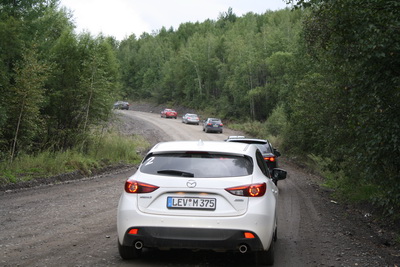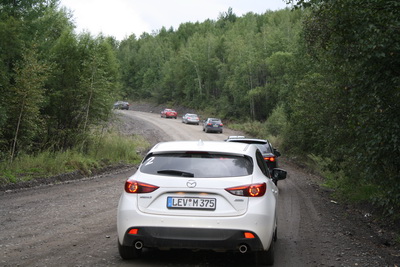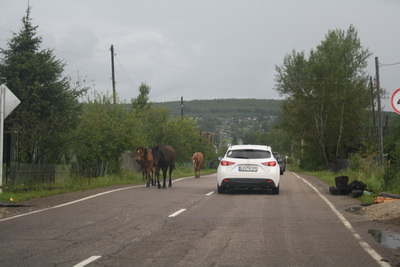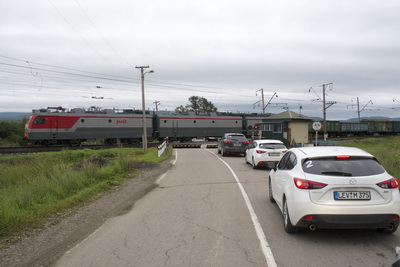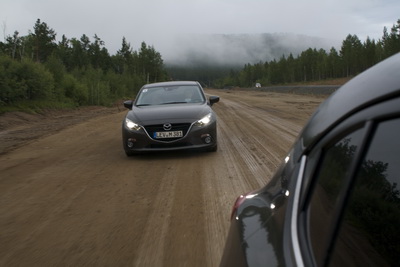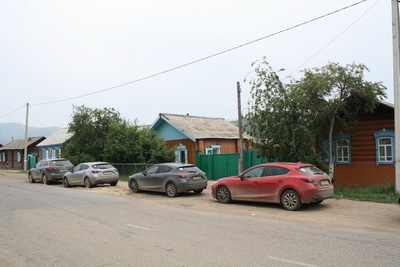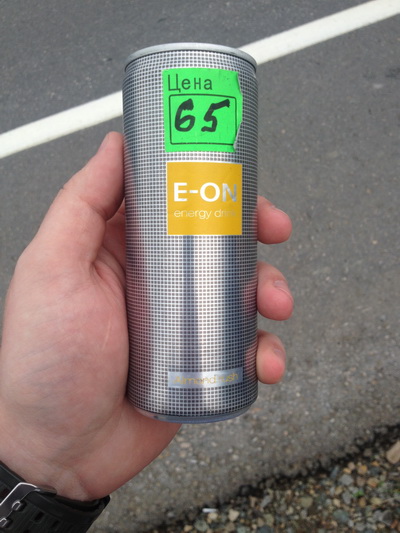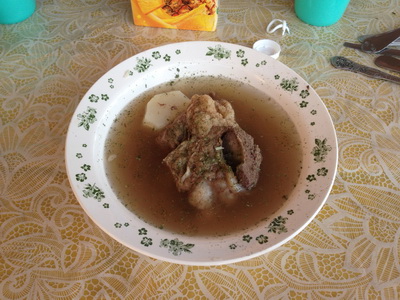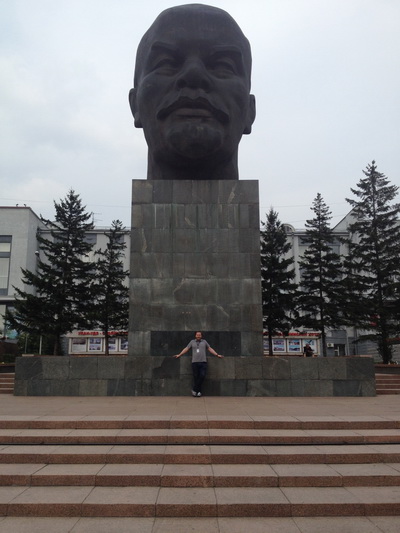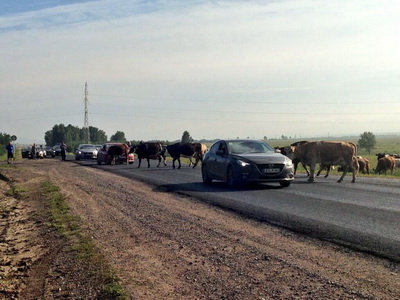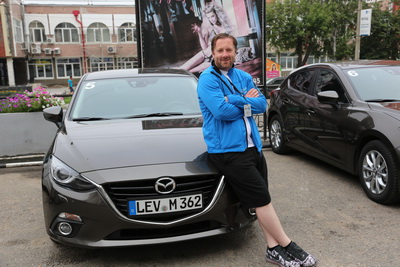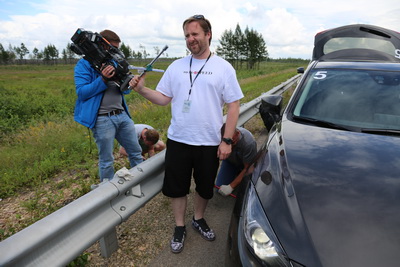It is quite a common occurrence to receive an invitation from a car manufacturer to attend a new model launch. It provides us with an opportunity to see, touch and drive the car before it's available to buy and gives us the chance to bring the news to the public. These events also give the car brands a chance to 'touch base' with us and there's all the usual news, gossip and speculation about what's going on in the industry.
But what is virtually unheard of is a car manufacturer asking for certain members of the media to actually make sure that the car gets to the launch in the first place. Yet this is exactly what Mazda wanted me to do when my phone rang back in late July.
*Phone rings*
"Hello?"
"Dave! It's Richard, how are you?!"
"Eh, great thanks, what's up?"
"I need to talk to you about a trip I've got coming up soon, and I reckon you're the man for the job. Lunch tomorrow?"
"Sure thing"
"Great, see you about 1. Oh, and it's Siberia!"
"WHAT?!"
*Click*
Even after the trip was outlined to me it still sounded bonkers - helping drive the new Mazda3 from the factory in Hiroshima, Japan, across the sea into Vladivostok and then driving all the way along the Chinese and Mongolian borders and crossing the vast expanse of Russia before eventually arriving (one month and 15,000km later) just one day before the opening of the Frankfurt Motor Show. Sounds simple, right?
Stage 2 of the trip would see the group collecting the cars from Blagoveshchensk, located on the Amur River, and in clear view of China across the 800-metre wide stretch of water. In a bold move, all cars had been left in totally standard form - no skid plates or suspension upgrades; the only difference being that they were all fitted with 16-inch wheels as this tyre size is the most commonly available on the route.
Day 1:
Having quickly acclimatised our body clocks to the local time, the first driver briefing took place outside our hotel in downtown Blagoveshchensk. Unlike the usual driver briefings, this one included various security protocols, tips about other road users and road conditions. Our eight cars would be joined by a six Mazda CX-9 support vehicles that would transport camera crews, event co-ordinators, local fixers, a doctor and our own personal security detail - some of which had served as bodyguards to a former Russian president.
We would have to contend with demanding road conditions, brave (or crazed depending on your perspective) local drivers as well as some long distances - 636km on the first day. As you may have seen from the numerous YouTube clips, Russian traffic can be unpredictable at the best of times, so guiding a fourteen-vehicle convoy through it was going to be challenging. Our support vehicles would block off and hold junctions as best they could, but as a back-up we would all be linked by walkie-talkie. Within the first ten minutes the convoy had already been broken up by the mental local traffic.
Once out of the city we began to get an idea of the vastness that is Russia. The route of the first day of driving would see us heading northwards, running parallel to the Chinese border and, at times, also running right alongside the Trans-Siberian Railway. It may look just like any other railway, but if you get the chance, go and look it up online and when you see the distance that it covers you will soon appreciate the engineering marvel that it is. Even with these vast distances, you never get the chance to zone out as what can seem like a perfectly good stretch of road can suddenly produce some very severe potholes, as we would later discover.
Despite being on the only real road for miles there is surprisingly little traffic, most of which is made up of heavy goods vehicles that all seem to be at least thirty years old. Along the road there is little in the way of scenery either, other than endless acres of dense pine forests, which contain so little gaps that the road can sometimes start to become hypnotic. Despite our best efforts at avoiding the potholes we eventually hit one pretty hard, although all seemed fine until about one hour later when the Mazda3's tyre pressure warning came on. We radio ahead to the lead car and the crew decides to pull in to check to be safe. Careful examination seems to show no issue with the rim or tyre so the convoy gets rolling once more.
Given the scale of the ground that we needed to cover on this trip, every stop, no matter how short would soon add up so a swift pace was kept where and when the roads permitted. It was on one such road that, after 30-40 minutes of quick driving our front right tyre would let go in equally quick fashion. Thankfully, at the point at which this happened road conditions were as good as we had seen all day and I was able to safely pull into the side of the road.
As soon as I brought the car to a halt the support crew were already springing into action, getting a spare wheel from the boot and grabbing tools when I seemed to surprise them by asking if I can change the wheel. They happily supervised while the film crew captured the whole process. Once up and running again we made steady progress without any further incident.
After one very heavy downpour we got clear roads for the rest of the day and as dusk began to set in we found ourselves on one last totally unpaved road that lead up into our overnight stop in what appeared to be a very small town, named Skovorodino. Our digs for the night were anything but glamorous, but no toys were thrown from the pram, as after that eventful first day of driving we were all glad to just have somewhere to put our heads down for the night.
Day 2:
Our overnight accommodation in Skovorodino may have been close to the size of a ship's cabin - minus air conditioning - but I did have the benefit of a 42-inch flat screen television, as well as a full-sized fridge-freezer unit. Either way, despite our diva-esque jokes, we were all secretly just glad to have somewhere to get a few hours' sleep. Having fuelled the cars up the night before, we would be able to hit the ground running today, and our first task would be to cross the Trans-Siberian Railway.
There can sometimes be little in the way of points of interest to stop and see when you're traveling on a trip like this - so stopping off to take a look at the largest road junction in Siberia came recommended. It may come as a surprise to you that this could also be called the quietest road junction in Siberia. Quite why the authorities decided to construct such an enormous motorway style junction in the middle of nowhere is that bit more mind-boggling when you stand there looking at it. The truth of the matter is that, despite the title, it is just about the same size as any motorway junction we have back here, but we decided not to tell the locals as they seem quite proud of it.
Our journey today would see us having to cover a hefty 910km and about a quarter of the way into it we find ourselves on well-paved, good roads so decent progress is being made. The striking scenery on this trip often reminds you of driving through different countries, such is the nature of the land here. Much of today's driving could be in Canada, were it not for the infrequent reminders of old Soviet Russia, while the more dense areas of pine forests give the impression of being in Finland.
After some 500 or so kilometres we pull in for lunch in the only place that seems possible - a roadside lay-by next to what may have once been a quarry. I'm not exaggerating either - there is literally nothing here, so thankfully the crew produce a picnic. When we stop the one constant that you can't help but notice is the sheer silence that meets you when you get out of the car. As someone who lives, eats and breathes city life, this is equally as refreshing as it is daunting - it reminds you that you truly are in the middle of nowhere. In the distance I spot a large bird of prey circling over a forest - one of the only examples of wildlife we have seen all day.
The rest of our day would see us notch up some serious mileage and thanks to better roads helps us to make some decent progress. That is until the Siberian roads claim another victim. This time it is Car 4 who has met a severe pothole and damaged both of its right wheels beyond repair. A thirty minute roadside break while they change the wheels allows the crew to top us up with some more Russian energy drinks, which we now are becoming dependent on. With the spare wheel supply now depleted by three in the last 24 hours, the Mazda crew are hoping that there aren't too many more incidents and ask us all once again to try to avoid the potholes. Easier said than done here!
On a long trip such as this it can sometimes be hard to gauge when to stop - you don't want to do it too often as it kills time, but you also don't want to leave it too long as you increase the risk of driver fatigue. Our next stop would be just for a quick driver change as we are now almost two-thirds of the way there. During this break we find an 'interesting' plant growing at the side of the road, which gives us great amusement as we pose with it for photos in the car - little did we know we almost sparked an international incident by tweeting said pics - all in good fun of course!
Approaching Chita, the roads got decidedly worse before entering the city, to the point where we were traveling along what was essentially a motorway constructed from compacted earth. Chita is a more developed city than our starting point in Blagoveshchensk, and seems to have quite a lot of industry surrounding it. There are cheers as we reach our hotel for the night, which does actually appear to be a real, proper hotel! All joking aside, everyone is happy to have made it through what would be the longest day of driving on the whole trip. It is also a testament to the Mazda3 that despite no additional prep work being carried out before the trip, the cars have made it thus far without incident (barring punctures).
Day 3:
Today we face an equally long 700-kilometre drive on what would be our final day on the road before handing the cars over to the next group for Stage 3. Our drive would end in the city of Ulan-Ude and promised us yet another day of spectacular scenery in which to travel through.
As much of Chita still slept we began to load up the cars before breakfast and managed just enough time for a quick stroll around the city as dawn broke. Like all large towns and cities that we had travelled through thus far, it didn't take us long to discover the large main square, which an impressive statue of Lenin looked over.
The one thing that rang through in every place we drove through was the seeming lack of modern transport - both public and private. With the exception of the odd brand new V8-powered Nissan Patrol or Toyota Landcruiser Amazon, the vast majority of cars seem to all be at least fifteen to twenty years old and are all far from showroom condition. Whether this is down to people not being able to afford something newer or the fact that they perhaps don't place the same emphasis on the materialistic nature of modern that we do back here in Western Europe remains unanswered. One thing is for certain though: those cars really have stood the test of time so far.
Once more we run parallel to the Trans-Siberian Railway as we leave Chita before heading out into the countryside. The further away that we drive from the city limits the more rural the residential areas become until we reach a point where small clusters of homes could barely be classed as shanty-towns. The roads have held up well so far, but every so often we come across a section of road that hasn't actually fallen into disrepair, it simply has never been paved. Following a kilometre or so of bouncing across what is essentially compacted gravel, we suddenly find ourselves back on a perfectly paved road again. This continues for some time until we are stopped in our tracks by a huge herd of cattle that have decided to amble across our path.
Following some car-to-car filming, we really need to put the foot down in order to catch up with the rest of the convoy who have gone on ahead. Our CX-9 camera car leads the way and we regularly see speeds approaching 180km/h. I watch their suspension in order to gauge just how bad the road surface is - after all, they have a little more suspension travel than we do. After some rather spirited driving we tag on to the back of the convoy once more and continue though some spectacular countryside.
For the next hour or so we travel along a thin black ribbon of tarmac in what is otherwise a vast expanse of scrubland. For as far as the eye can see, there is neither a bush nor tree in sight. I have never before experienced a country that can host such a different variety of countryside in which to travel though, and yet on this stage of the trip we are crossing just a tiny part of Russia in the grand scheme of things.
Unlike undertaking a vast road trip in Europe where services are never that far away, in these parts of Siberia when you begin to run low on fuel you do become acutely aware of it. As we all fuel at the same time, we generally all have the same fuel ranges and as a backup each car has a 25-litre jerry can of extra fuel in the boot. We arrive into our next planned fuel stop with just over 50km of fuel remaining before being told that the station is completely out of fuel. Normally this would cause a level of stress but in this case we are in luck and another station isn't too far away.
With our tanks eventually topped up we set out on the final leg of our journey into the city of Ulan-Ude. On this final leg we would be making a detour to a museum commemorating The Decembrists, who were essentially exiled out to this area of Siberia at the turn of the century. This isolated outpost is still now home to several hundred families and is steeped in historical importance. Judging by the reaction of several locals as our convoy rolled into town, it isn't a place visited very often by foreigners.
Despite being a shorter day distance-wise, with the additional stops during the day, dusk was beginning to fall as we approached our final destination. For the final time we cross the Trans-Siberian Railway before adopting some defensive driving as we approach downtown Ulan-Ude.
In what is almost a full circle, the final city we end up in - Ulan-Ude - is quite a bustling place and has far more of an Asian feel about it, which, given that it is located not far from the Mongolian and Chinese borders, isn't surprising. The few locals that we meet seem incredibly and genuinely friendly much like the locals we have met everywhere along the way on this trip.
Having flown halfway around the globe and squeezed over 2,500km of driving into just a few days, the Mazda3 Challenge is without a doubt an event that I think none of us will ever forget. Aside from the spectacular sights, the bizarre and also hilarious incidents, there was of course the unsung star of the week - the new Mazda3.
When you consider that these eight cars turned up in absolutely standard trim, with no reinforcement or protection, and they performed (with the exception of some wheel-killing potholes) faultlessly. Some would argue that we were nothing more than delivery drivers and to a degree they would be correct. But rather than a mere test drive, we drove, ate, drank and slept in these cars over all kinds of terrain and at the end of Stage 2 there was very little that could be said to criticise them. The interior is extremely comfortable and as well put together as cars that cost a lot more. The 2.0-litre petrol engine that got us to Ulan-Ude may not have been the most powerful in its class, but the prospect of this car with the 2.2-litre diesel engine is a very attractive one that could certainly prove to be a Golf-beater.
Personally the first time I see one of these new cars on my local roads I will be transported back to what was undoubtedly one of the greatest driving trips I have ever had the pleasure of taking.

